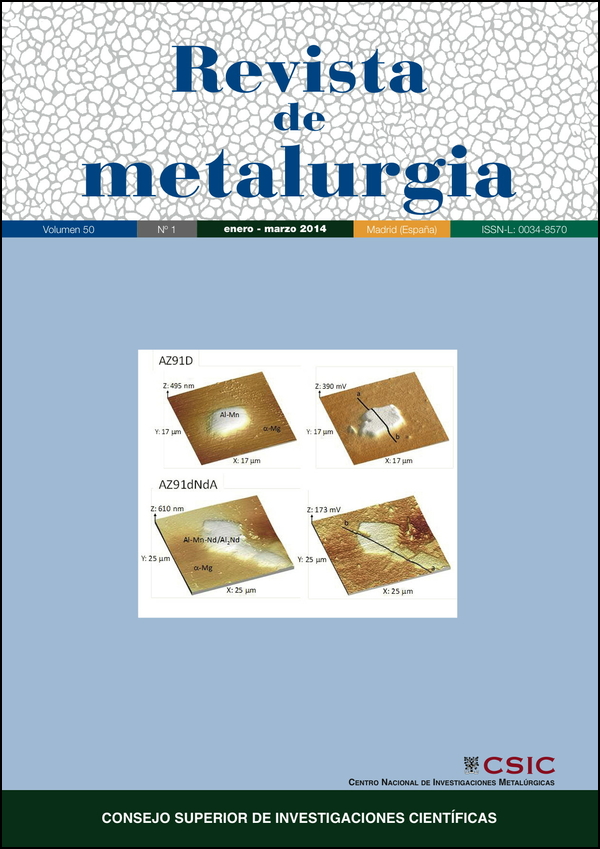Cyclic and isothermal oxidation behavior of 2.25Cr-1Mo steel
DOI:
https://doi.org/10.3989/revmetalm.003Keywords:
Boiler steel, High temperature corrosion, Kinetic law, Thermal cyclingAbstract
Cyclic and isothermal oxidation of chromium-molybdenum steel 2.25Cr-1Mo were analyzed at 550 °C and 650 °C during 360 hours in air atmospheres. The cycles were performed with two stages; one of heating in furnace during 90 minutes and then the sample were cooled to 50 °C by air flow. Thermogravimetric analyses were performed to obtain high temperature corrosion kinetics. Several characterization techniques have been used to identify the corrosion mechanism, as X-Ray Diffraction (XRD), Optical Microscopy (OM) and Scanning Electron Microscopy (SEM). Thermal cycling tests can changes the corrosion mechanism, due cracks propagation in oxide scale, that witch can favors the access of oxidant agent to the substrate.
Downloads
References
Buscail, H., Caudron, E., Cueff, R., Issartel, C., Perrier, S. y Riffard, F. 2003. Yttrium sol-gel coating effects on the cyclic oxidation behaviour of 304 stainless steel. Corros. Sci. 45 (12), 2867–2880. http://dx.doi.org/10.1016/S0010-938X(03)00114-8
Chen, R.Y., Yuen, W.Y.D. 2010. Short-time Oxidation Behavior of Low-carbon, Low-silicon Steel in Air at 850-1,180 °C-III: Mixed Linear-and-Parabolic to Parabolic Transition Determined Using Local Mass-Transport Theories. Oxid. Met. 74 (5–6), 353–373. http://dx.doi.org/10.1007/s11085-009-9180-z
Gardiner, D.J., Littelton, C.J. y Thomas, K.M. 1987. Distribution and characterization of high temperature air corrosion products on iron-chromium alloys by Raman microscopy. Oxid. Met. 27 (1–2), 57–72. http://dx.doi.org/10.1007/BF00656729
Hanesch, M. 2009. Raman spectroscopy of iron oxides and (oxy) hidroxides at low laser power and possible applications in environmetal magnetic studies. Geophys. J. Int. 177 (3), 941–948. http://dx.doi.org/10.1111/j.1365-246X.2009.04122.x
Henry, J.F., Tanzosh, J., Stanko, G., Shingledecker, J., Vitalis, B., Purgert, R. y Viswanathan, R. 2005. U.S. program on materials technology for ultra-supercritical coal power plants. J. Mater. Eng. Perform. 14 (3), 281–292. http://dx.doi.org/10.1361/10599490524039
Muddle, B.C. y Singh Raman, R.K. 2002. High temperature oxidation in the context of life assessment and microstructural degradation of weldments of 2.25Cr–1Mo steel. Int. J. Pres. Ves. Pip. 79 (8–10), 585–590.
Sarver, J., Tanzosh, J.M. y Viswanathan, R. 2006. Boiler materials for ultra-supercritical coal power plants-Steamside oxidation. J. Mater. Eng. Perform. 15 (3), 255–274. http://dx.doi.org/10.1361/105994906X108756
Seifert, W., Thomas, R. y Rhede, D.F. 2010. Origin of coexisting wustite, MgFe and REE phosphate minerals in graphite-bearing fluorapatite from the Rumburk granite. Eur. J. Mineral. 22 (4), 495–507. http://dx.doi.org/10.1127/0935-1221/2010/0022-2034
Viswanathan, R. y Bakker, W. 2001. Materials for ultrasupercritical coal power plants-Boiler materials: Part 1. J. Mater. Eng. Perform. 10 (1), 81–95. http://dx.doi.org/10.1361/105994901770345394
Wu, X., Kuang, W., Han, E.H., Rao, J. 2011. The mechanism of oxide film formation on Alloy 690 in oxygenated high temperature water, Corros. Sci. 53 (11), 3853–3860. http://dx.doi.org/10.1016/j.corsci.2011.07.038
Xie Y., Wang M., Zhang G. y Chang M. 2006. Analysis of superalloy turbine blade tip cracking during service. Eng. Fail. Anal. 13 (8), 1429–1436. http://dx.doi.org/10.1016/j.engfailanal.2005.07.022
Yoon, K.B. y Jeong, D.G. 1999. Oxidation failure of radiant heater tubes. Eng. Fail. Anal. 6 (2), 101–112. http://dx.doi.org/10.1016/S1350-6307(98)00033-8
Yoshinaga M., Kishimoto H., Yamaji K., Brito M.E., Xiong Y., Yokokawaza H. y Horita T. 2011. Effects of Thermal Cycling on the Formation of Oxide Scale of Fe–Cr Alloy Interconnects for Solid Oxide Fuel Cells. Int. J. Appl. Ceram. Technol. 8 (6), 1374–1381. http://dx.doi.org/10.1111/j.1744-7402.2010.02600.x
Young, D.J. 2008. High Temperature oxidation an corrosion of metals, Ed. Elsevier, Amsterdam, Holanda, pp. 497–498.
Published
How to Cite
Issue
Section
License
Copyright (c) 2014 Consejo Superior de Investigaciones Científicas (CSIC)

This work is licensed under a Creative Commons Attribution 4.0 International License.
© CSIC. Manuscripts published in both the printed and online versions of this Journal are the property of Consejo Superior de Investigaciones Científicas, and quoting this source is a requirement for any partial or full reproduction.
All contents of this electronic edition, except where otherwise noted, are distributed under a “Creative Commons Attribution 4.0 International” (CC BY 4.0) License. You may read the basic information and the legal text of the license. The indication of the CC BY 4.0 License must be expressly stated in this way when necessary.
Self-archiving in repositories, personal webpages or similar, of any version other than the published by the Editor, is not allowed.
















